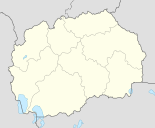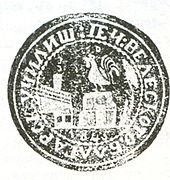Veles (North Macedonia)
| Veles Велес Veles / i or Qyprilli / u Köprülü |
||||
|---|---|---|---|---|
|
||||
| Basic data | ||||
| Region : | Vardar | |||
| Municipality : | Veles | |||
| Coordinates : | 41 ° 43 ' N , 21 ° 47' E | |||
| Height : | 225 m. i. J. | |||
| Area (Opština) : | 427.45 km² | |||
| Residents : | 43,140 (2016) | |||
| Inhabitants (Opština) : | 54,384 (2016) | |||
| Population density : | 127 inhabitants per km² | |||
| Telephone code : | (+389) 043 | |||
| Postal code : | 1300 | |||
| License plate : | VE | |||
| Structure and administration | ||||
| Structure : | 29 localities | |||
| Mayor : | Ace Kocevski ( SDSM ) | |||
| Website : | ||||
Veles ( Albanian Veles / i, Turkish Köprülü) is a city in the center of the Republic of North Macedonia on the Vardar River . It is the capital of a municipality of the same name .
Surname
Veles is the current name of the city in the Macedonian language ( Cyrillic Велес ) as well as in the Albanian language , in which the certain form Velesi is also used. In Greek it is called Βελεσά Velesa , and in Turkish Köprülü , from which the city was also known as Keuprulu or Keuprili (Albanian Qyprilli / -u ).
The origin lies in the ancient name of the city Bylazora or Vilaz-ora , which is to be assumed as a compound name, the second part of which corresponds to the Albanian word ura (" bridge "). The Turks also later gave the city a name based on the Turkish word for "bridge", köprü .
history
Ancient and Middle Ages
The city in Paionien has been populated since ancient times. During antiquity, the fortified city was located a little south of today's local area, at the mouth of the Topolka River in the Vardar. As early as 216 BC Chr. Is Dardanian place Vilaz-ora 168 mentioned, v. He came under Roman rule. In Roman times, the city was in the shadow of the Stobi , a little further down the river , which is now a ruined city. In the 6th century the Slavic settlement of the area began, in the 9th and 10th centuries the place belonged to the Bulgarian Empire , from 1018 back to the Byzantine Empire and was administratively combined in the Byzantine province of Bulgaria . After the restoration of the Bulgarian Empire in 1185 and the strengthening of Raszien , the region between the Bulgarian, Byzantine and Serbian empires and the Kingdom of Thessaloniki was controversial, but local rulers such as Vukašin Mrnjavčević and Chreljo were also able to assert themselves at times .
Ottoman era
In the 14th century the Serbs conquered the area. Soon afterwards the period of Ottoman-Turkish rule began for Veles . In the middle of the 16th century, the Ottoman traveler Hajji Kalfa mentioned the city. Another description of Köprülü from the high Ottoman period (16th / 17th century) can be found in the “travel book” (Seyahatnâme) of the Ottoman traveler Evliya Çelebi . 1704 described the Serbian monk Jerotej Račanin in his work Putašastvije k gradu Ierusalimu Veles as a Bulgarian city, which is called by the Ottomans "Küprülija".
The city was ravaged by the plague in 1831 and 1840 . At the beginning of the 20th century, Veles was connected to the Ottoman railway network by the Skopje – Thessaloniki railway line.
In the course of the Tanzimat reforms of 1839, a Bulgarian community was able to form in the 1840s, which donated the first New Bulgarian school and the church of St. Pantaleon in the city and in 1867 a library and print shop ( Christo Danow print shop ). A detailed description of Veles by the Russian consul in Bitola is known from 1862 . In 1870 the city became the seat of an eparchy and a metropolitan of the Bulgarian Exarchate by a decree of the Sultan ( Berât ) . Genadij von Veles became the first Bulgarian metropolitan . According to the ethnography of the Vilayets d'Andrinople, de Monastir et de Salonique from 1878, Veles had 1470 households with around 6000 male inhabitants in 1873, 4884 of them Bulgarians (including mainly the ancestors of today's Macedonians). In the 1890s, the city is said to have had a population of around 19,700. Around 1905 the city had 13,820 inhabitants. At that time there were two Bulgarian Progymnasiums and primary schools in the city , or one Serb, one Greek and one Aromanian Progymnasium and primary school.
Part of Serbia and Yugoslavia
In the First and Second Balkan Wars , up to 306 volunteers from Veles fought against the Ottomans and Serbs as part of the 9th Veles Battalion of the Macedonia-Adrianople Volunteer Corps of the Bulgarian Army . After the Second Balkan War, Veles, like the entire area of what is now North Macedonia, was assigned to the Kingdom of Serbia . Most of the Muslim and Bulgarian populations were subsequently displaced. During the First and Second World Wars , the city and the entire region were captured by Bulgaria . During these periods Veles was administered by IMRO .
With the takeover of the city by Tito's partisans and the ASNOM , at Christmas 1944 the collaborators and members of the IMRO as well as people professing Bulgarianism were mistreated and sometimes murdered without trial or judgment. The victims were behind the church “St. Spas ”. After the Second World War, the city belonged to communist Yugoslavia and was named Titov Veles after the head of state Josip Broz Tito . During this time the city was industrialized, which led to social and economic change.
Since 1991
After the independence of the Republic of Macedonia in 1991, a break in the economic life of the city followed (as in other North Macedonian cities: Ohrid , Bitola , Tetovo and others). The large businesses were closed and the standard of living fell sharply. The Act on the territorial division of Macedonia ( Macedonian Законот за територијлната поделба на Република Македонија и одредување на единиците на локалната самоуправа на Македонија ), the town got its old name - Veles - back.
In 2016, the city gained international fame because of the massive amount of fake news spread from the town on social networks during the US presidential election campaign . Residents created websites on which they placed fake news and advertisements, and posted the links, etc. a. in numerous Facebook groups. When users of the social networks clicked on the fake news websites, the website operators received money from the advertising.
population
city
According to the 2002 census, the city of Veles has 43,716 inhabitants, besides Slavic Macedonians (92.12%) also Turks (3.88%), Roma (1.83%), Aromanians (0.78%), Serbs (0, 68%), Albanians (0.21%) and others.
In 2016, the population was estimated at 43,140.
local community
In Opština Veles , which also includes other localities besides Veles, there are 55,108 inhabitants (2002; estimated 2016: 54,384). The ethnic breakdown is made up as follows:
| Ethnicity | Residents | proportion of |
|---|---|---|
| Macedonians | 46,767 | 84.86% |
| Bosniaks | 2.406 | 4.36% |
| Albanians | 2,299 | 4.17% |
| Turks | 1,724 | 3.12% |
| Roma | 800 | 1.45% |
| Serbs | 540 | 0.97% |
| Wallachians | 343 | 0.62% |
| Other | 229 | 0.41% |
| Total | 55,108 | 100% |
Note: the percentages are rounded to two decimal places
economy
Along with the North Macedonian capital Skopje and Bitola, Veles is one of the country's economic centers. The geographic location has favored economic development since ancient times. The largest butter factory in the country and a zinc factory are located here today.
Veles has also achieved notoriety as a center for deliberate fake news .
traffic
After Skopje, Veles is the country's second rail hub. The Veles railway station located on the north-south mainline Tabanovci-Gevgelija . From here the Veles – Kremenica railway branches off to the southwest and the Veles – Kočani railway to the northeast .
Attractions
Churches
- St. Pantaleon Church
- Church of the Assumption of Mary
- Sveti Spas Church
- Monastery of St. Dimitrius
Further
- Veles clock tower
- Kale of Veles (fortress)
- theatre
- Folk museum
People associated with the city

- Dimitar Trajkowitsch (1817–1880), Bulgarian freedom fighter and politician
- Raiko Schinsifow (1839–1877), Bulgarian writer
- Ilija Georgow (1860–1945), Bulgarian journalist and politician
- Ivan Georgow (1862–1936), Bulgarian philosopher, scientist and founder of modern Bulgarian philosophy
- Dimitar Matow (1864-1896), Bulgarian scientist
- Miletij von Veles (1868–1924), Bulgarian clergyman
- Kâzım Özalp (1880–1968), Turkish politician and military
- Andrej Mazanow (1880–1947), Bulgarian freedom fighter and leading figure in the BMARK
- Panko Brašnarov (1883–1951), communist leader
- Kočo Racin (1908–1943), communist leader and writer
- Kiril Lazarov (* 1980), Macedonian handball player
Twin cities
Web links
Individual evidence
- ↑ veles.gov.mk
- ↑ a b Veles. In: mirjanadetelic.com. Retrieved March 27, 2018 (Serbian).
- ↑ Jordan Vančev: Новобългарската просвета в Македония през Възраждането. 1982, pp. 94-95.
- ↑ detailed description of Veles from 1862 ( Memento from October 4, 2010 in the Internet Archive )
- ^ Almanac Macedonia , 1931
- ↑ V. Kanchoff: Macedonia. Etnography and Statistics
- ↑ DMBrancoff: La Macédoine et sa population Chrétienne. Paris 1905, pp. 118-119.
- ↑ Bulgarian State Archives (from the bul. Главно управление на архивите): Македоно-одринското опълчение 1912–1913 г. Личен състав. Sofia 2006, pp. 833-834.
- ↑ Newspaper " Nova Makedonija " from 23.II.1991, p. 13.
- ^ City of Liars Online from December 18, 2016, accessed on December 28, 2016
- ↑ How Facebook powers money machines for obscure political 'news' sites The Guardian, August 24, 2016, accessed December 28, 2016
- ↑ Ethnic composition of Macedonia 2002. In: pop-stat.mashke.org. Retrieved April 16, 2018 .
- ↑ a b Macedonia: Statistical Regions & Settlements - Population Statistics, Maps, Graphics, Weather and Web Information. Retrieved April 15, 2018 .
- ↑ 2002 census: official result, p. 34 (PDF; 394 kB)
- ↑ Westfalenpost: Fake news from Macedonia - Veles is the home of lies




